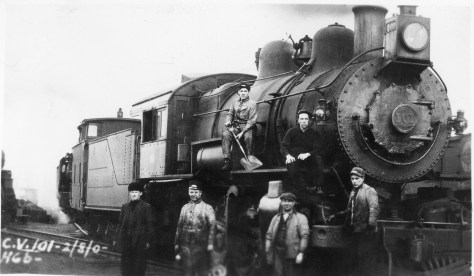I work with photographs almost every day. Often, I’m faced with drafting captions for historic images and too often I find historic prints without adequate information.
Back in the day some conscientious photographer made the effort to preserve a scene. When they went out the reason for their photograph was often brutally obvious (to them).
Maybe a new locomotive was working the daily express, or the local passenger train was running late. Perhaps an old machine was nearly ready for the scrap heap, or something special was on the move.
Or maybe it was just a nice day to be out, and the photographer wanted to document the railroad action.

Holding an un-captioned photo may present many mysteries that could have been easily answered at the time of exposure. But the photographer passed on and the significance of the moment has been forgotten; the railroad was merged out of existence decades ago and the location has changed beyond recognition.
And so here I am trying to solve a mystery. Often, I can figure things out. But not always.
There maybe clues, but will they help? If you could find the location today, you might see that the double track line in the old print was reduced to single iron and the old station was bulldozed years ago, the mills in the distance are now the site of a shopping plaza, and trees have grown up everywhere.

A captioned photograph is vastly more useful, more valuable, and more relevant than an uncaptioned print. Never assume that the viewer, or even the photographer himself/herself will remember the details. The passage of time tends to blur those things that once seemed obvious.

A solution for future photos: take the time to write information on the images photos you make. If you caught something special, explain in detail. Never assume.
Be sure to include specifics regarding locations. Avoid potentially cryptic abbreviations.
Don’t make things up! Try to be as accurate as possible without wildly speculating as to important details such as date and location.
Don’t wait until you have 100,000 photographs that span 25 years to begin your task.

Beware: some time ago, an archivist told me that un-labeled photo collections are considered to be of low value to the historian. (His words were a bit stronger and involved trash receptacles).
A few final thoughts; when labeling old prints consider the type marker you use. Colored felt-tip pens are a very poor choice. For RC prints, consider a thin black permanent marker that won’t bleed, or a black ball-point pen with good action and ink that doesn’t smear. For paper prints a light pencil is a good choice, but don’t press down so hard that you damage the image area. Paste on labels are not good, eventually the glue will dry up (and fall off) and also the glue may bleed through. Digital images need captions too, but that’s a topic for another day.
More examples and more mysteries soon!
Tracking the Light Posts Daily!
Please help by forwarding Tracking the Light to your friends!
Very interesting and informative. I like your pic of Bob Buck at “The Cross”. So many times I remember enjoying his company there, with the pictures, mags and articles he would bring to talk about. I still miss him….and the times you would join us!
RC = resin coated. The popular type of photographic paper widely used since the 1970s.
I recall Bob’s cursive hand writing. I assume he learned in Warren as a lad. This is another loss in the current age. TSH
The cabooses in the IC picture are interesting. There seem to be at least three different designs among the five lined up. They might offer a clue to the cognoscenti.
I assume RC prints have no religious significance!